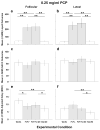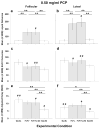Increased impulsive choice for saccharin during PCP withdrawal in female monkeys: influence of menstrual cycle phase
- PMID: 23344553
- PMCID: PMC3656971
- DOI: 10.1007/s00213-012-2963-y
Increased impulsive choice for saccharin during PCP withdrawal in female monkeys: influence of menstrual cycle phase
Abstract
Background: In previous studies with male and female rhesus monkeys, withdrawal of access to oral phencyclidine (PCP) self-administration reduced responding for food under a high fixed-ratio (FR) schedule more in males than females, and with a delay discounting (DD) task with saccharin (SACC) as the reinforcer impulsive choice for SACC increased during PCP withdrawal more in males than females.
Objectives: The goal of the present study was to examine the effect of PCP (0.25 or 0.5 mg/ml) withdrawal on impulsive choice for SACC in females during the follicular and luteal phases of the menstrual cycle.
Materials and methods: In component 1, PCP and water were available from two drinking spouts for 1.5 h sessions under concurrent FR 16 schedules. In component 2, a SACC solution was available for 45 min under a DD schedule. Monkeys had a choice of one immediate SACC delivery (0.6 ml) or six delayed SACC deliveries, and the delay was increased by 1 s after a response on the delayed lever and decreased by 1 s after a response on the immediate lever. There was then a 10-day water substitution phase, or PCP withdrawal, that occurred during the mid-follicular phase (days 7-11) or the late luteal phase (days 24-28) of the menstrual cycle. Access to PCP and concurrent water was then restored, and the PCP withdrawal procedure was repeated over several follicular and luteal menstrual phases.
Results: PCP deliveries were higher during the luteal (vs follicular) phase. Impulsive choice was greater during the luteal (vs follicular) phase during withdrawal of the higher PCP concentration.
Conclusions: PCP withdrawal was associated with elevated impulsive choice for SACC, especially in the luteal (vs follicular) phase of the menstrual cycle in female monkeys.
Figures


Similar articles
-
Sex and menstrual cycle effects on chronic oral cocaine self-administration in rhesus monkeys: Effects of a nondrug alternative reward.Psychopharmacology (Berl). 2016 Aug;233(15-16):2973-84. doi: 10.1007/s00213-016-4343-5. Epub 2016 Jun 18. Psychopharmacology (Berl). 2016. PMID: 27318989 Free PMC article.
-
Impulsivity as a behavioral measure of withdrawal of orally delivered PCP and nondrug rewards in male and female monkeys.Psychopharmacology (Berl). 2009 Nov;207(1):85-98. doi: 10.1007/s00213-009-1636-y. Epub 2009 Aug 21. Psychopharmacology (Berl). 2009. PMID: 19697013
-
Effects of a non-drug reinforcer, saccharin, on oral self-administration of phencyclidine in male and female rhesus monkeys.Psychopharmacology (Berl). 2003 Oct;170(1):9-16. doi: 10.1007/s00213-003-1487-x. Epub 2003 Jul 1. Psychopharmacology (Berl). 2003. PMID: 12838382
-
Sex differences in the escalation of oral phencyclidine (PCP) self-administration under FR and PR schedules in rhesus monkeys.Psychopharmacology (Berl). 2005 Jul;180(3):414-26. doi: 10.1007/s00213-005-2182-x. Epub 2005 Mar 1. Psychopharmacology (Berl). 2005. PMID: 15739077
-
Reduction of drug self-administration by an alternative non-drug reinforcer in rhesus monkeys: magnitude and temporal effects.Psychopharmacology (Berl). 2000 Jan;147(4):418-25. doi: 10.1007/s002130050011. Psychopharmacology (Berl). 2000. PMID: 10672636
Cited by
-
Reward maximization assessed using a sequential patch depletion task in a large sample of heterogeneous stock rats.Sci Rep. 2023 Apr 29;13(1):7027. doi: 10.1038/s41598-023-34179-8. Sci Rep. 2023. PMID: 37120610 Free PMC article.
-
How to study sex differences in addiction using animal models.Addict Biol. 2016 Sep;21(5):1007-29. doi: 10.1111/adb.12400. Epub 2016 Jun 26. Addict Biol. 2016. PMID: 27345022 Free PMC article. Review.
-
Deprivation Has Inconsistent Effects on Delay Discounting: A Review.Front Behav Neurosci. 2022 Feb 10;16:787322. doi: 10.3389/fnbeh.2022.787322. eCollection 2022. Front Behav Neurosci. 2022. PMID: 35221945 Free PMC article.
-
Characterization of a differential reinforcement of low rates of responding task in non-deprived male and female rats: Role of Sigma-1 receptors.Neuropharmacology. 2021 Dec 1;200:108786. doi: 10.1016/j.neuropharm.2021.108786. Epub 2021 Sep 10. Neuropharmacology. 2021. PMID: 34516984 Free PMC article.
-
Anhedonia, avolition, and anticipatory deficits: assessments in animals with relevance to the negative symptoms of schizophrenia.Eur Neuropsychopharmacol. 2014 May;24(5):744-58. doi: 10.1016/j.euroneuro.2013.10.001. Epub 2013 Oct 14. Eur Neuropsychopharmacol. 2014. PMID: 24183826 Free PMC article. Review.
References
-
- Allen SS, Hatsukami DK, Christianson D, Nelson D. Withdrawal and pre-menstrual symptomatology during the menstrual cycle in short-term smoking abstinence: effects of menstrual cycle on smoking abstinence. Nicotine Tob Res. 1999;1:129–142. - PubMed
-
- Allen SS, Hatsukami DK, Bade T, Center B. Transdermal nicotine use in postmenopausal women: does the treatment efficacy differ in women using and not using hormone replacement therapy? Nicotine Tob Res. 2004;6:777–788. - PubMed
-
- Anker JJ, Carroll ME. Females are more vulnerable to drug abuse than males: evidence from preclinical studies and role of ovarian hormones. In: Neill JC, Kulkarni J, editors. Biological Basis of Sex Differences in Psychopharmacology. Vol. 8. Springer; London, UK: 2011. pp. 73–96. Current Topics in Behavioral Neurosciences. - PubMed
Publication types
MeSH terms
Substances
Grants and funding
LinkOut - more resources
Full Text Sources
Other Literature Sources

